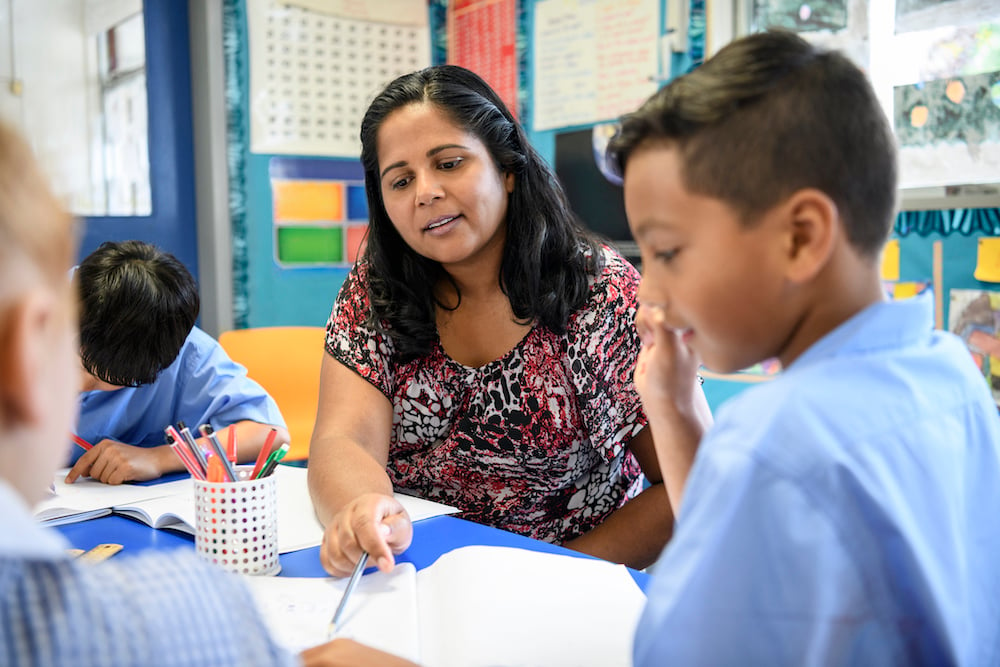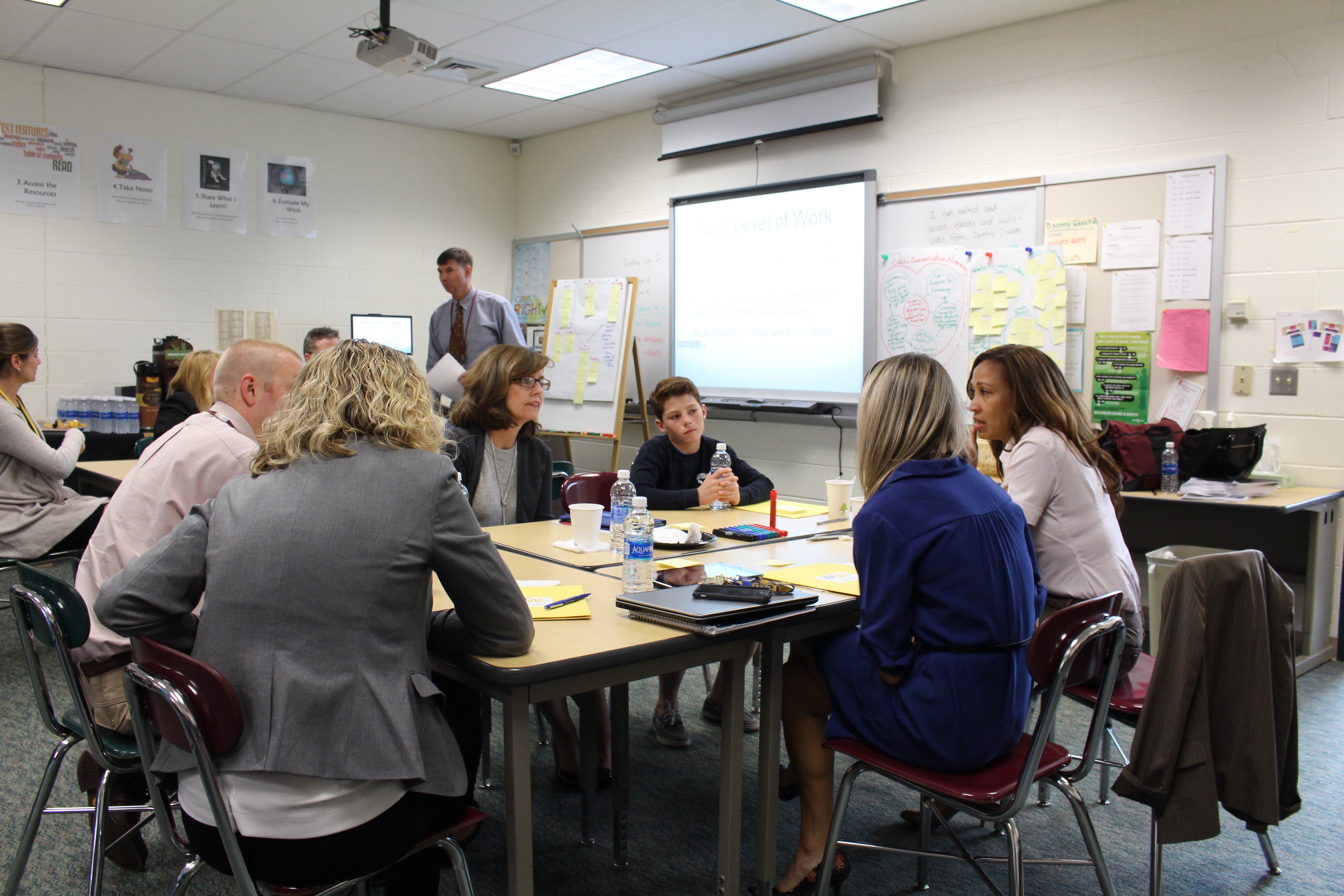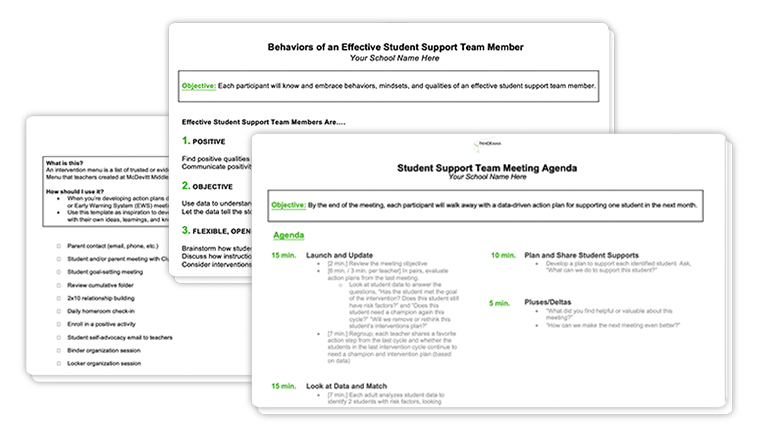A multi-tiered system of supports (MTSS) can get complicated quickly. With so many educators and students involved across different school buildings, it’s hard for district leaders to keep track of all of those moving parts.
In order to have a comprehensive system across a district, leaders must align with educators at each school around expectations, practices, and processes. How can district leadership ensure that schools have a framework for providing student support?
The answer lies in the Student Support Team (SST). An SST is a school-based team that focuses on intervention planning. SSTs provide a collaborative and data-driven approach to helping students succeed by identifying and addressing the academic, behavioral, and life skills needs of students.
Let’s explore how clear expectations, processes, and practices can help SSTs and other school-based MTSS teams become champions for tiered support in classrooms and schools across a district.
Access our three most popular templates for rolling out a district-wide MTSS.
What is a Student Support Team?
A Student Support Team is a type of school-based MTSS team that focuses on planning targeted interventions for individuals or groups of students.
Never heard of an SST? That’s because this learning structure goes by many different names. In your district, these teams may be called:
- Intervention Teams
- Tier 2 and 3 Problem-Solving Teams
- Student Study Team
- Grade Level Teams
- Something completely different!
No matter the name, the function and structure of this team is roughly the same from district to district. Typically composed of educators, counselors, administrators, and other specialists, SST members work together to provide targeted support to students. This work can include:
- Early Identification: SSTs work to proactively identify student needs and intervene before small issues become larger problems that negatively impact progress. These can relate to academic growth, attendance, or behavior management.
- Providing Individualized Support: The SST creates a tailored plan for each student based on their unique needs, and monitors student progress toward pre-determined goals. Any student in a school can be given targeted supports, not just students in special education settings.
- Facilitating Cross-Functional Collaboration: SSTs promote collaboration between classroom teachers, counselors, administrators, and other specialists. This helps ensure that no student falls through the cracks.
Each team has around 4–6 members, and schools may have more than one SST, depending on the size and needs of the student body. To ensure all SSTs in a district are aligned and doing similar work, many districts employ a district-level MTSS coordinator to communicate with school-based teams.
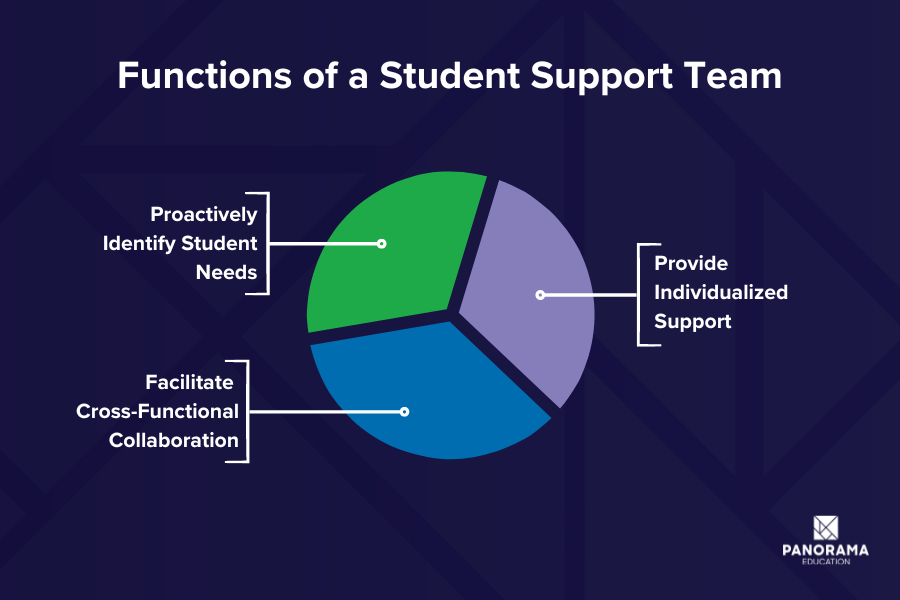
The Functions of a Student Support Team
3 Ways District Leaders Can Support SSTs
In order to achieve alignment across a district, it’s important that district leadership provides some direction on how these teams function within the larger MTSS. Here are three ways leaders can support SSTs through expectations, process, and practice.
1. Define what it means to be an effective Student Support Team member
Leaders need to set clear expectations for support team members. Being on an SST can put team members outside of their typical day-to-day roles, and they may need to adopt a new set of behaviors and mindsets in order to be successful.
Think of these expectations like a job description. What do you hope each team member will bring to the table?
Educators at Bastrop Independent School District (TX) developed their own list of expectations for members of support teams: positive, objective, flexible, and prepared. Those qualities of an effective Student Support Team member are:
-
Positive: Finds positive qualities and bright spots in data to discuss with team members, and positively communicates with families, students, and colleagues
-
Objective: Thoughtfully uses data to understand and report on students’ present grades, assessments, behavior, and attendance
-
Flexible: Brainstorms how students can make progress, and considers interventions and adaptations that can help a student meet goals
-
Prepared: Arrives on time, ready to review data and discuss information about students, and respects the time of other team members.
"With these guidelines, I’ve noticed that the conversations in meetings are very different,” says Jennifer Greene Gast, an Academic RTI Coordinator at Bastrop. “They are very solutions-focused. There’s a lot more kindness, compassion, and understanding when we’re talking about supporting the whole student."
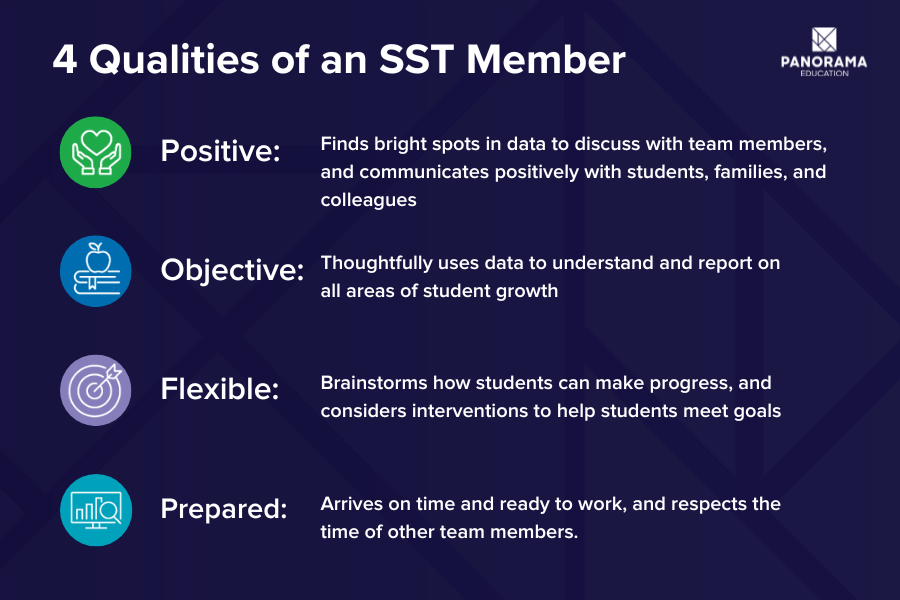
Bastrop ISD's 4 Qualities of a Student Support Team Member
2. Set a strong meeting agenda for school-level MTSS teams
It's important to build time into school schedules for support teams to collaborate. These team meetings can take different shapes depending on who's participating and how much time is available. SSTs should aim to meet on a weekly basis.
Teams should decide what meeting structure works best for them, but it’s always helpful to have a starting point for an SST process. Use the elements below (inspired by the agenda used at Waltham Public Schools, MA) to craft an agenda for your SST meetings:
1. Launch the meeting and evaluate intervention progress (15 minutes)
Educators give quick updates on the students they've been supporting, and note whether or not the students still need a champion and intervention plan.
2. Review student data and make new "matches" (15 minutes)
Educators analyze data to identify students who are showing signs of struggle and may need to receive Tier 2 interventions. Team members should consider risk factors across all areas— academics, behavior, attendance.
3. Plan and share student supports (10 minutes)
During this portion of the meeting, educators will develop an intervention plan to support each newly identified student. As part of the planning process, team members may consider:
- which adult will be the student’s “champion”
- which goals to set for the student
- which interventions will be used in the action plan
- how often the educator champion will deliver the intervention
- how the student’s progress will be monitored
4. Reflection and closing (5 minutes)
Reserve five minutes at the end of each meeting to reflect. What did team members find helpful or valuable about the meeting? What would make the next meeting even better?
|
With Panorama Student Success, you can easily filter student rosters by assessment scores, grades, behavior notes, and other key indicators. Then, build a goal-based intervention plan on a student's profile by setting a goal, timeline, intervention strategy, and progress monitoring method. Once saved, the intervention plan will be visible to other educators on the Student Support Team. |
3. Standardize interventions across literacy, math, and behavior
The magic of MTSS is in personalization. When educators carefully choose interventions for each student’s unique needs, they ensure that that child is getting the best possible support.
While no single intervention will work for every student, it's important for educators to have a starting point. This is why many districts develop an intervention menu: a collection of approved strategies across all areas of student growth.
Be sure to make this resource readily available during intervention meetings so team members can easily discuss and choose the best strategy for their students.
Remember, an intervention menu is not a fixed resource. As you learn more about your students and what works in your context, continue to add new interventions to the menu. Here are 18 research-based interventions to help you get started.
Key Takeaways and Next Steps for Successful Student Support Teams
Every student support team will look a little different, but these elements can help any team achieve success:
- Set clear expectations for what it looks like to be a successful MTSS team member
- Make the most of meetings with a strong, consistent agenda that puts the focus on supporting student growth
- Align teams around a collection of district-approved strategies across academics and behavior to ensure students are getting access to interventions that fit their needs
By keeping these three ideas in mind, you can set your school-based intervention teams up for success and ensure that they are getting the information and resources they need to support every student.
Click here to download our MTSS/RTI implementation kit with free templates.


.jpeg)
![3 Strategies for Building Effective Student Support Teams [+ Templates]](https://www.panoramaed.com/hubfs/IMG_3959.jpg)
